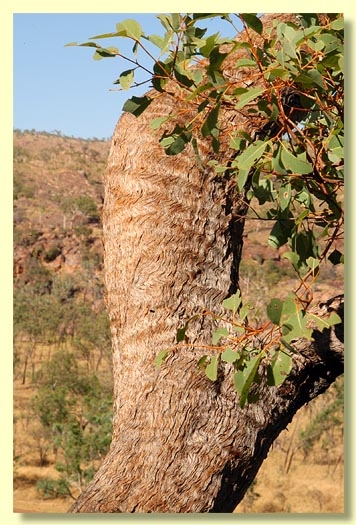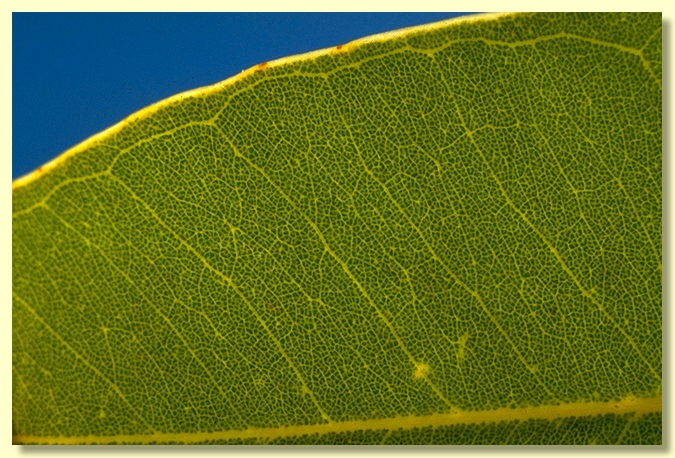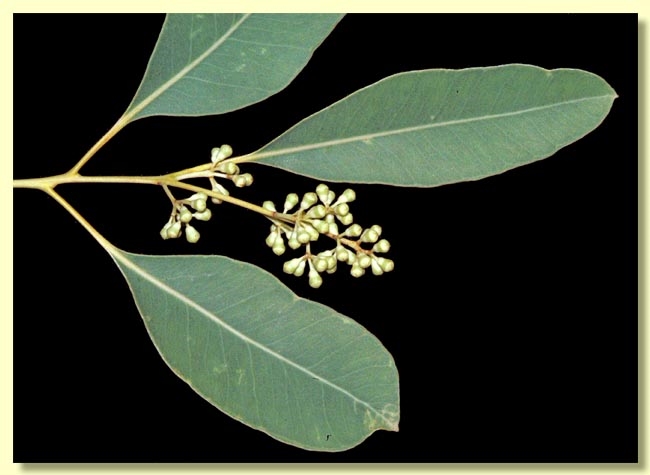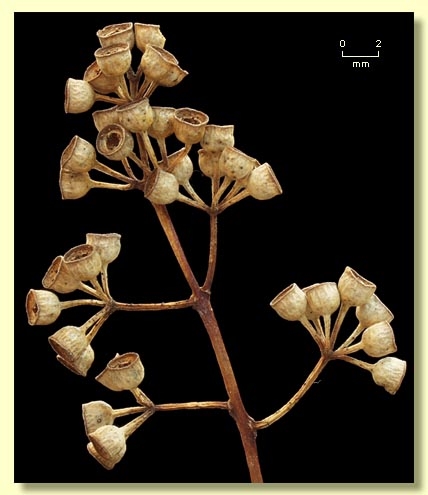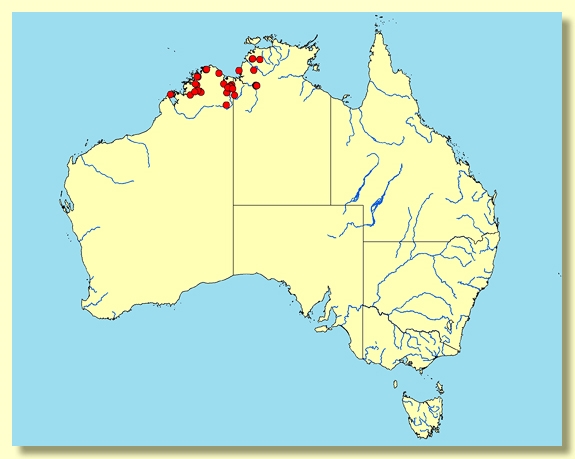Euclid - Online edition
Eucalyptus brachyandra
Eucalyptus | Minutifructus | Domesticae
Tree to 8 m tall, orsometimes a mallee or shrub. Deciduous in the dry season. Forming a lignotuber.
Barkrough to small branches, fibrous to stringy, grey to brown or sometimes the larger branches smooth, grey to white.
Branchlets lack oil glands in the pith; non-glaucous or occasionally glaucous.
Juvenile growth (coppice or field seedlings to 50 cm): stems ?rounded in cross-section, not glaucous; juvenile leaves always petiolate, opposite, orbicular to ovate or elliptical, 2.5–8 cm long, 1.5–6 cm wide, base tapering or rounded, apex rounded to bluntly pointed or emarginate, glabrous, light green to grey-green.
Adult leaves predominantly alternate, petioles 0.8–2.6 cm long; blade elliptical to oblong or ovate, rarely lanceolate or sub-orbicular, 3.3–9.7 cm long, 0.9–4.5(6) cm wide, base usually tapering to petiole, rarely rounded, apex rounded or broadly pointed, rarely emarginate, margin entire, discolorous, dull, pale green to grey-green, side-veins usually at greater than 45° to midrib, reticulation very dense, intramarginal vein present close to margin, oil glands obscure.
Inflorescence predominantly terminal compound, sometimes a few smaller compound axillary inflorescences present in the upper leaf axils, peduncles 0.1–1 cm long, buds 3 or 7 per umbel, shortly pedicellate, rarely almost sessile (pedicel 0–0.4 cm long). Mature buds pyriform, 0.25–0.4 cm long, 0.2–0.25 cm wide, smooth, scar present (outer operculum shed early), operculum rounded, sometimes apiculate, stamens inflexed or irregularly flexed, all fertile, anthers ± versatile, ± basifixed, globose to reniform to butterfly-shaped, dehiscing by lateral slits, style short, ca half the length of the floral cavity, straight, stigma blunt to tapered, locules 3 or 4, the placentae each with 5 or 6 vertical ovule rows. Flowers creamy white.
Fruit sessile or, more usually, pedicellate (pedicels 0–0.4 cm long), cupular to campanulate, hemispherical or urceolate, 0.2–0.3 cm long and wide, rim thin, disc broad, level or obliquely descending, below rim of fruit, valves 3 or 4, below rim level but level with disc.
Seeds brown, 0.4–1 mm long, cuboid to flattened-ovoid, sometimes pointed at one end, dorsal surface shallowly reticulate, hilum ventral.
Cultivated seedlings (measured at ca node 10): cotyledons bilobed; stems ?rounded in cross-section; leaves always petiolate, opposite for at least 14 pairs, ovate-elliptic, 2.5–7 cm long, 1.5–4.5 cm long, base tapering to rounded, apex rounded or pointed, dull, green to grey-green, discolorous, dull.
Flowering has been recorded in August, September, October and November.
A tree of straggly form, sometimes reduced to a shrub, restricted to drier parts of monsoonal north-western Australia. It is found from the south-western part of the Top End of the Northern Territory, from Tabletop Range south to Victoria River Gorge and Jasper Gorge, west through the Kimberley region of Western Australia, from Wyndham south to Carr Boyd Range, further west to Artesian Range and north to Napier Broome Bay. It occurs on margins of sandstone plateaus and on exposed ridge-tops and is distinguished by the finely stringy or fibrous bark that usually extends to the small branches, the terminal compound inflorescences, strongly petiolate elliptical-oblong leaves that are dull green above and paler green below, and tiny buds (to 0.3 cm long and 0.2 cm wide), amongst the smallest in the genus Eucalyptus.
Eucalyptus brachyandra is unlikely to be confused with any other eucalypt. Within the natural range of E. brachyandra only E. rupestris has similarly small buds and fruit but arranged in solitary axillary 7-budded umbels. In addition E. rupestris has smooth white bark over the trunk and branches, seasonally powdery or satiny.
In the classification of Brooker (2000) Eucalyptus brachyandra is placed in Eucalyptus subgenus Minutifructus comprising only four tropical species sharing the characteristics of terminal compound inflorescences, discolorous leaves with dense reticulation and small buds with outer sepals (or operculum) lost very early and an inner petaline operculum that persists until flowering, and tiny fruit. The other three species are E. howittiana, a species from tropical north-eastern Queensland, with thick-textured lanceolate leaves, full box-type bark and hillslope habitat; E. raveretiana, a partly rough-barked tree with long broadly lanceolate leaves endemic to north Queensland and found on alluvial soils along streams; and the extra-Australian tropical tree species E. deglupta, which has multicoloured smooth bark and opposite ovate leaves, and forms pure stands on river flats. E. deglupta is sporadically distributed from New Britain though Papua New Guinea; West Papua, Celebes, and Ceram in Indonesia; and Mindanao in the Philippines.
Eucalyptus brachyandra: Greek brachy, short and andra, male, referring perhaps to the short stamens.


